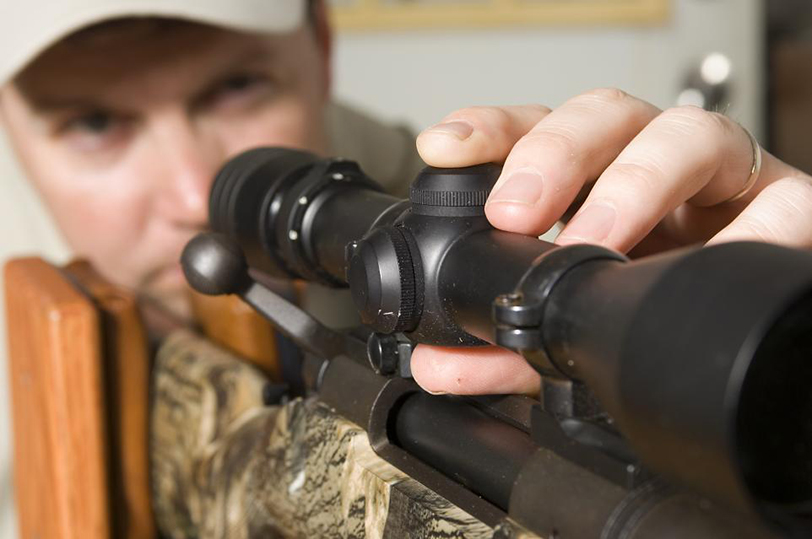If you want to shoot with long-range precision, you’ll need a center point scope. Installing and learning how to sight a rifle scope takes some technical expertise, but even a novice may learn to use this useful shooting accessory if they follow these easy steps.
To begin, make sure you have the required information and equipment, as well as paying close attention to safety. To zero your rifle scope, follow these seven steps.
-
CONFIRM THAT THE SCOPE IS SET UP PROPERLY.
A scope mounting system is common on most modern rifles. If your rifle has pre-drilled and tapped holes for scope bases or a grooved rail system like the Weaver or Picatinny rail systems, you’ll want to make sure your scope mount and rings are a good match. Certain scope rings are only compatible with certain CenterPoint scopes bases. It’s vital that these elements match.
-
ADJUST YOUR EYE DISTANCE
Place your eyepiece so that you can see a clear, distinct picture. A key component of sighting your rifle scope is fine-tuning the scope and having the ideal amount of eye relief – the gap between the end of the scope and your eye. You must ensure that the distance between your eye and the scope is adequate so that when you fire a shot, the recoil does not cause the scope to return far enough to make contact with your eye, resulting in serious injury. This is referred to as “being scoped.”
You’ll need a stable shooting spot to accurately sight your rifle’s scope. You have the choice of mounting your gun on a shooting bench or using a bipod. While either approach will achieve the desired result, a rifle mount will minimize recoil by up to 95% while firmly holding the rifle on target.
There are a number of rifle mounts designed specifically for scope sighting that is available in a variety of price ranges.
-
RETICLE ALIGNMENT
When zeroing in their scope, the majority of shooters forget the orientation of their recticle. Recycle Cant happens when the crosshairs of your lens are not precisely matched to the directions of the elevation and windage changes. Your shots can miss to the right or left of the target due to a canted reticle. Particularly when shooting at a target from a distance of more than 250 yards.
-
Defining YOUR MOA (MINUTE OF ANGLE)
The method of deciding your zero consists of several steps. Since you’ll need targets set at different distances – at least 100 yards – you would find it easiest to do it at an outdoor shooting range. To keep your rifle steady, you’ll also need amount.
The crosshairs can then be set in 14 MOA (minute of angle) increments on most rifle scopes. When sighting in at 100 yards, this equates to 14” of movement per click. The most common click values used by hunters are 1/8 inch and 1/4 inch MOA.
At 100 yards, you must turn the height, or windage knob four times to shift the bullet impact one inch or one MOA. For every 100 yards of distance, the click value increases by 1/4 inch.
For different distances, here is an incremental list of movement per click of the elevation or windage knob on your rifle scope:
- 1/2 inch = 200 yards
- 3/4 in. = 300 yards
- 1 inch equals 400 yards
- 1 1/4 in. = 500 yards
- 1 1/2 in. = 600 yards
- 1 3/4 in. = 700 yards
- 2 in. = 800 yards
Take note of where three-shot groups land on the target after firing them. You will want to sight in slightly high at 100 yards and fire dead center at 200 yards, depending on the application. It’s all up to you. You’ll be able to adapt to goals at various distances if you know your MOA.
-
CONTINUE TO TWEAK
Experiment with various distances before you can reliably hit clustered shots that are really similar to the bullseye. After you’ve mastered that, you can focus on reaching targets that are farther away, remembering to account for not only the rifle scope and distance to the target but also environmental factors such as wind.
Installing and sighting a rifle scope is a vital skill for a sharpshooter to learn, and if you follow the basic steps outlined here, you’ll gain the courage to continue honing your target shooting skills. Make use of the resources available to you, especially the expert firearms instructors at The Range 702, who can ensure that you have the right tools and are forming good habits while learning.
For more information, visit: smzsite.com/









